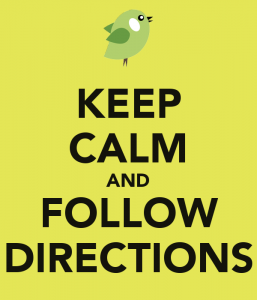There’s never time to do it right, but there’s always time to do it over.
Imagine that I hand you two identical boxes that contain identical contents.
One of the two boxes comes with a set of instructions to assemble the contents. The second box comes with no instructions. Suppose I told you that you had exactly one hour to complete the assembly.
Which box would you choose?
If you’re sane, you’d choose the box that comes with instructions. Why make your like difficult, right? 
But that’s exactly what it’s like for the creative department when you give them a project without a creative brief. You handicap them from the start.
Why on Earth would any professional communications firm even contemplate handing over a communications project to its creative team without a set of instructions? Why? Would someone please explain this concept to me? Because I just don’t get it.
Yet it happens. Every week or so I get an email from a reader or fellow creative bemoaning his or her situation where the creative brief (ad-speak for “set of instructions”) either does not exist, is ignored or is given lip service at best.
There is more truth to the cliche that the worst communicators are people in the communications business. They’re outstanding at talking to everyone on the planet…except themselves. They know every trick in the book to reach this audience or that, but when it comes to commiserating with each other, they are mute. They think the rules don’t apply to them.
This is a sad state of affairs.
If the decision makers where you work wouldn’t try to assemble the contents of a box without instructions, and that stark fact doesn’t convince them to use a creative brief, what can you do?
I have some advice that could change their minds.
I have witnessed more spinning wheels when a creative brief is ignored or underutilized. Meaning that creative work is rejected internally or by the client, or both, because something was missing, something was overlooked. More often, something was simply not clear.
The result is predictable: The creative team is forced to go back to the drawing board, but not necessarily with any clearer direction. Sometimes this happens repeatedly. I have painful memories of one project early in my career where I revised copy 17 times before it was finally approved. I learned quickly not to take it personally.
There is another route. The creatives will actually figure out the project, deliver some good (maybe even great) work and everyone is happy. This happens more often than you might imagine.
The question is: Why must it be this way when there is an alternative?
It doesn’t have to be this way.
Here’s how you can fix the problem: Try an A–B split. 
If you’re not versed in direct response, this means that you conduct a test with two approaches to the same project: one team gets a creative brief, the other doesn’t. If the creative brief isn’t part of your agency’s culture, you’ll have to do your best to create a template and fill in the boxes yourself. You must acquire evidence to show tangibly what happens when a brief is a part of the project from the beginning.
My experience shows that a creative team working from an inspired creative brief delivers better work the first time with fewer re-dos and miss hits.
You may have to try this experiment without buy-in from your bosses. You may also have to do it on the sly. You absolutely must find a creative (or an account exec) so there is collaboration between the two groups. Creatives will leap at the chance to work from a creative brief if none is currently available. Account folks should too, but may need persuading.
If your agency is too small for multiple teams on the same project, then choose two projects with similar objectives, similar target audiences or similar creative tone.
The point is, build your case for the creative brief with experience using a creative brief. Specifically, you should be able to answer the following questions in the affirmative before the work is submitted for review:
1. Is the direction from a creative brief clear, resulting in focused creative solutions?
2. Does the single-minded proposition inspire good thinking?
3. Is there an insight about the product or the target consumer that also inspires good thinking?
4. Does the creative brief establish a yardstick against which creative solutions can be assessed? In other words, can you say for certain whether or not a creative solution is “on brief” or “off brief”?
5. Does the brief establish clear expectations regarding the tone of voice for your product or service?
You’ll notice that these five questions are variations of those you would find on a creative brief itself.
So how do you measure the results of creative solutions arrived at “with” a creative brief versus those “without” a creative brief? A degree of subjectivity is inevitable, but if the creative solutions (meaning the ad ideas or concepts) address these questions successfully, you have demonstrated that the set of instructions you wrote (the brief) delivered creative that followed those instructions. Sometimes, that’s proof enough of the creative brief’s value.
Essentially, you have shown that #4 is achievable: You’ve proven that creative can be assessed, and your brief is the yardstick. 
This is the most important criteria for any brief: You set the bar at a certain height and ask whether or not the work at least achieves it. If it exceeds that height, wow. What a benefit. If it underachieves, you have a way of discerning why (the standards established by the brief) and a way to fix what doesn’t measure up.
Without a brief, how can you know if the work is good enough? Even if everyone in the room agrees that the work is good, even great, can they say why?
Since no one created a check list in advance (another way to describe a creative brief), no one can say with assurance that the work they see fulfills any criteria.
Your creative brief becomes the check list. The road map. The yardstick. The standard to which you can point and ask, “Did we get it right?” 
Don’t let another day slip by if your creative work place does not use a creative brief. Don’t deny yourself the opportunity to work with a set of instructions. It’s very possible to assemble a piece of furniture from Ikea without any, but why would you want to even try?
The creative brief doesn’t make producing ideas easy. Hard work takes care of that. But it certainly makes everyone’s life easier…if you put it to the test for which it was designed.

